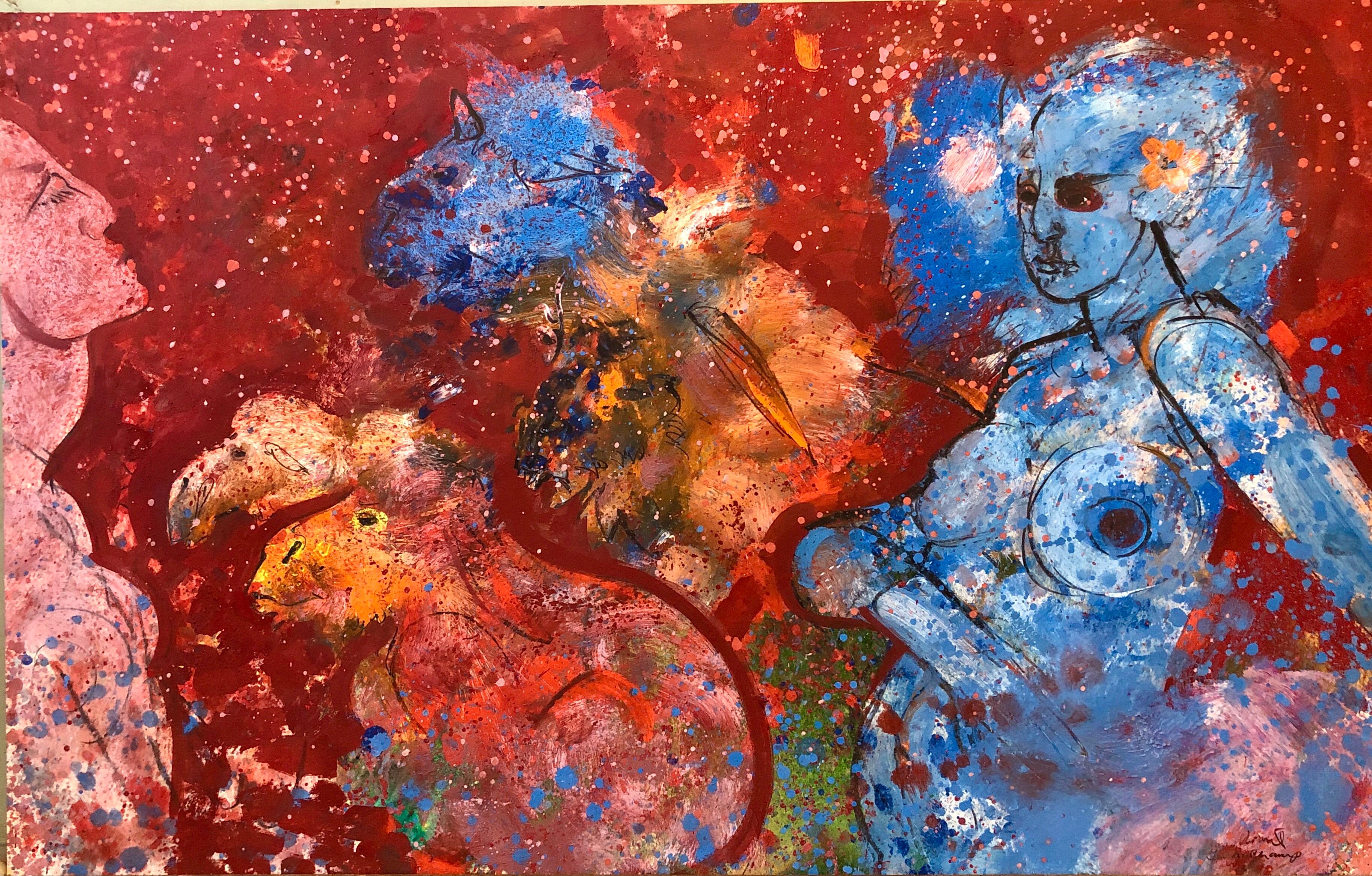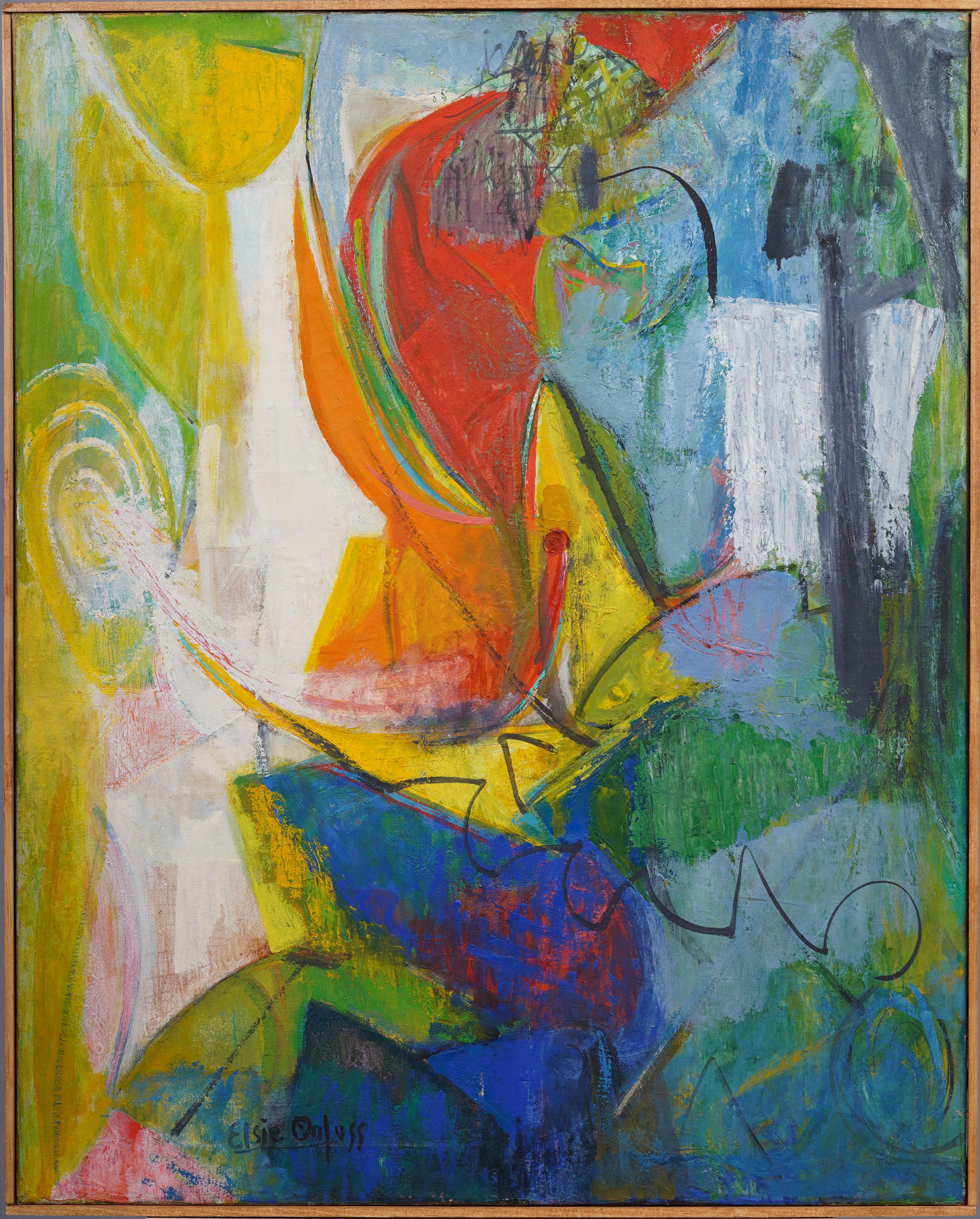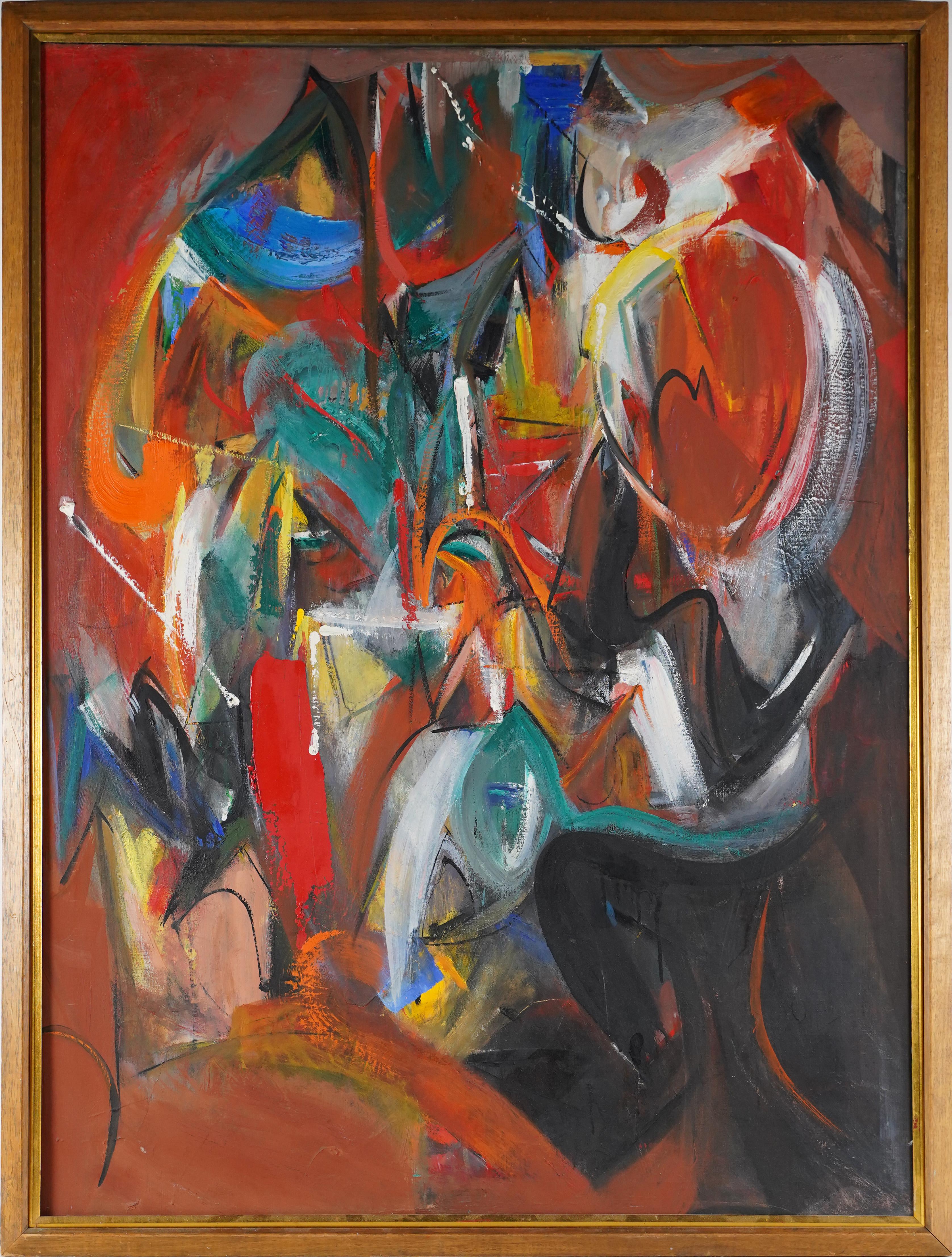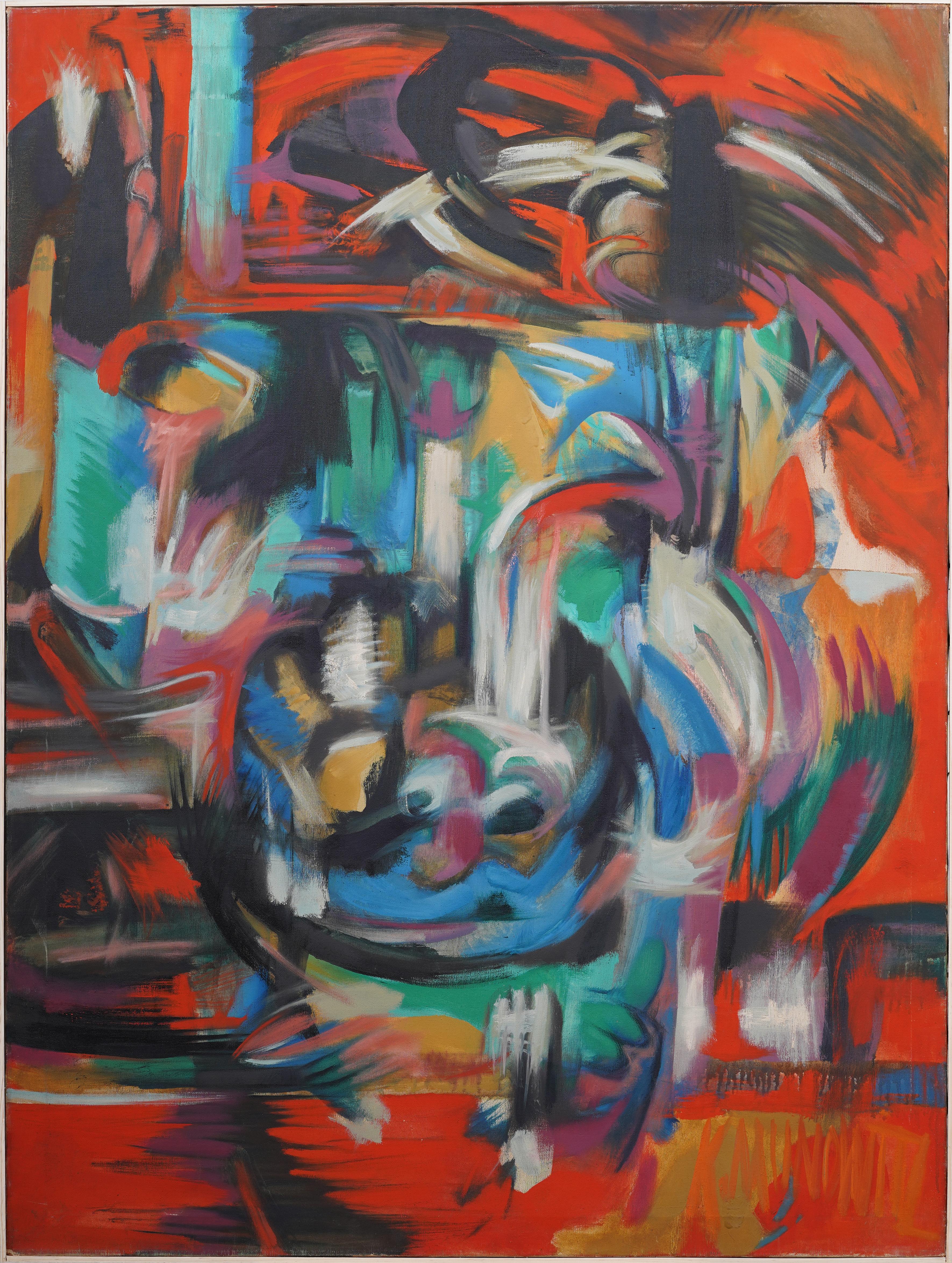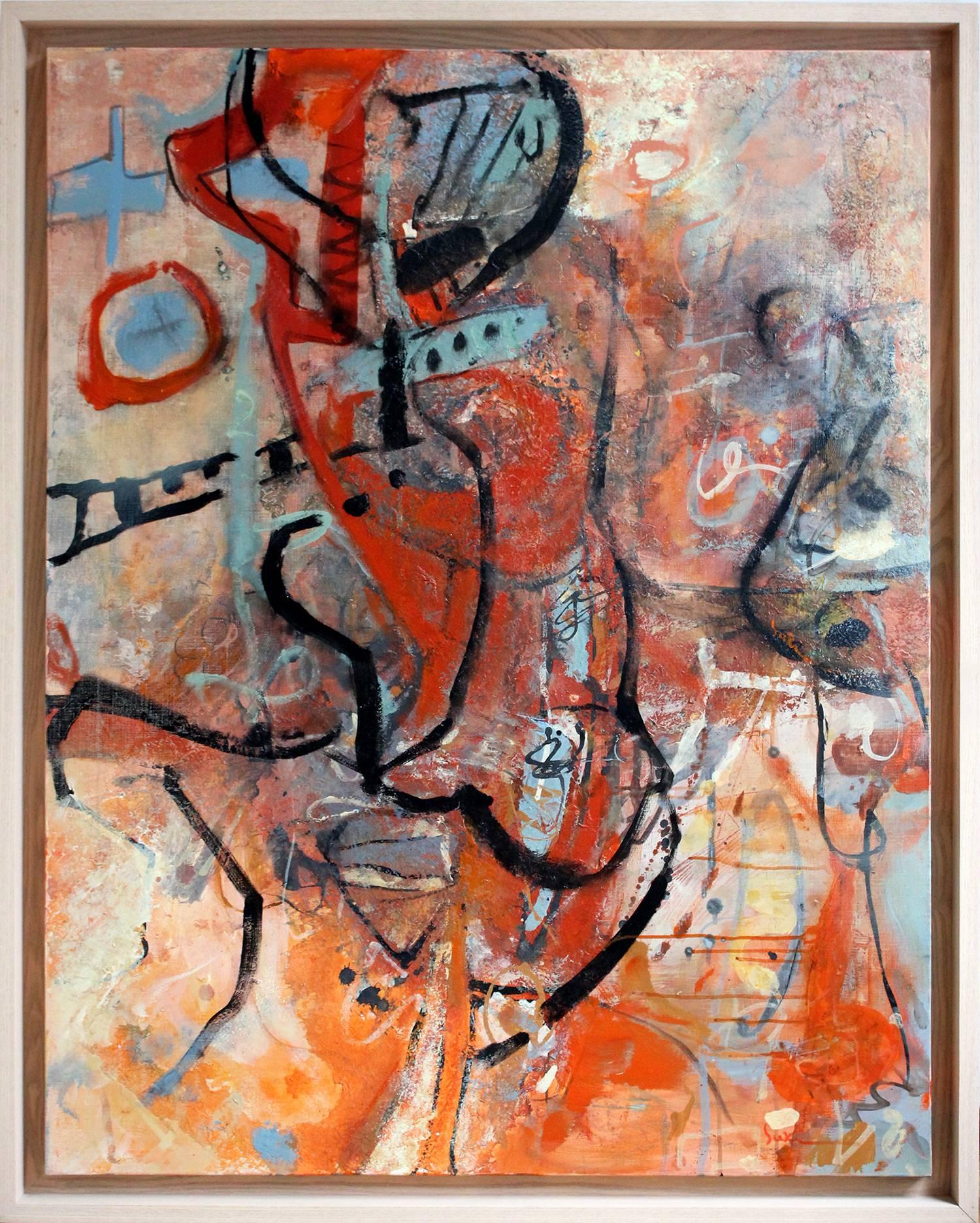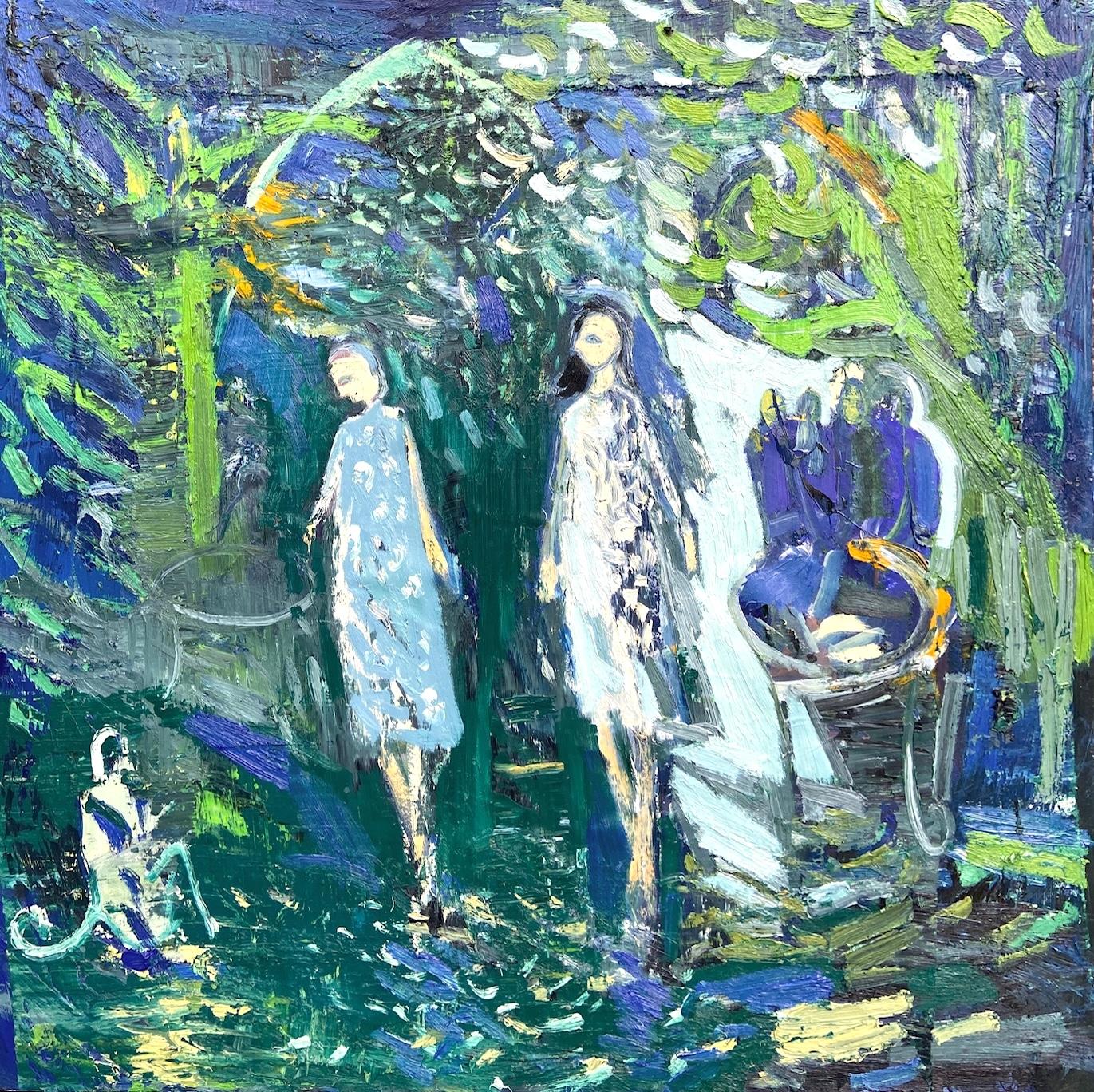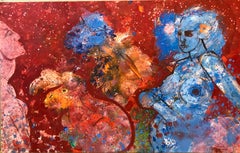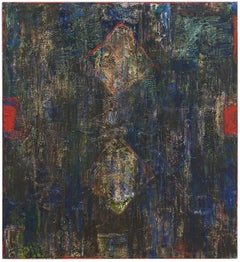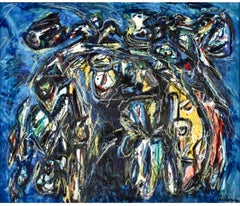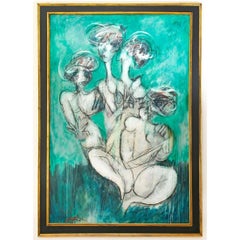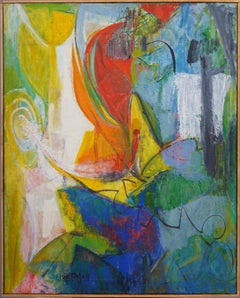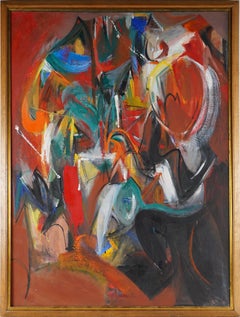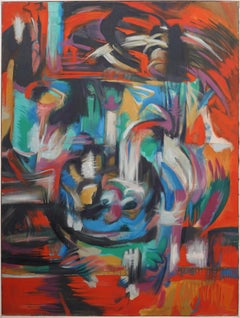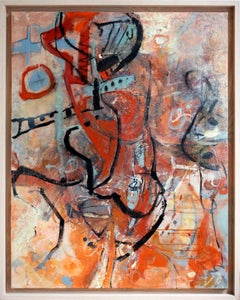Items Similar to American Neo Expressionist Woman with Monkeys Abstract Modernist Oil Painting
Want more images or videos?
Request additional images or videos from the seller
1 of 17
Robert BeauchampAmerican Neo Expressionist Woman with Monkeys Abstract Modernist Oil Painting
$2,800
£2,104.86
€2,440.20
CA$3,909.24
A$4,378.55
CHF 2,278.31
MX$53,177.19
NOK 28,883.12
SEK 27,253.38
DKK 18,207.37
Shipping
Retrieving quote...The 1stDibs Promise:
Authenticity Guarantee,
Money-Back Guarantee,
24-Hour Cancellation
About the Item
Robert Beauchamp, American (1923-1995)
Untitled
Hand signed lower right, titled verso.
MIxed media oil painting on heavy art paper
sight: 22 3/4 x 29 1/2 inches
frame dimensions: 23 1/4 x 30 1/4 x 1 1/4 inches, metal frame with glazing
Provenance: Private Collection. Frame inscribed 'Property of AT&T' Bears label from their corporate art collection.
Robert Beauchamp (1923 – March 1995) was an American figurative painter and arts educator. Beauchamp's paintings and drawings are known for depicting dramatic creatures and figures with expressionistic colors. His work was described in the New York Times as being "both frightening and amusing,". He was a Guggenheim Fellow and a student of Hans Hofmann.
Robert Beauchamp was born in Denver, Colorado in 1923. He had three brothers and three sisters, and the children were orphaned by both parents by the time Beauchamp was three. The family grew up impoverished due to the Great Depression, living in a community house with other families. As a child he dabbled in art but it wasn't until high school that he began taking art classes. When not creating art he also played sports; football and basketball, and enjoyed chemistry and geology.
He was told he was good at drawing, and replaced study hall classes with art classes, receiving instruction and inspiration from a Welsh teacher named R. Idris Thomas. While in high school Beauchamp would go, every Monday, to the public library and a local museum where he would read books about art; specifically French painting, as assigned by Thomas. Beauchamp absorbed the tenets of European Modernism and American Abstract Expressionism—with which he eventually broke. While abstraction, with its focus on color and form, underlies his compositions, he filled canvas and paper with psychologically acute portraits of himself and others, nudes, animals, and objects of all kinds. Beauchamp would spend upwards of four hours a day in the art room and eventually won the Carter Memorial Prize, which provided a scholarship to the Colorado Springs Fine Arts Center. At Colorado Springs he studied under Boardman Robinson, painting landscapes in nature.
Beauchamp eventually joined the Navy and then returned to Colorado Springs to continue his studies. Traveling the world as an Armed Guard, he spent a year and a half at sea and the rest of the three years in San Francisco. Seeking to make money, and to follow his love for a girl, Beauchamp decided to attend Cranbrook Academy of Art from 1947–1948. There he studied pottery, believing one could "make more money selling pots than you could selling paintings." He described his experience at Cranbrook as intimidating and claustrophobic, and eventually switched to sculpture before switching to painting.
Beauchamp moved to New York City in the early 1950s and was involved in the Tenth Street galleries, which provided outlets for more experimental artists and the second generation of abstract expressionists. Despite his involvement with 10th Street and friendships with abstract artists, abstract art never interested in him. He showed at numerous galleries in New York and Provincetown, socializing with gallery owners, artists and collectors. His first exhibition was at the Tanager Gallery in New York, he also showed during the 1950s at the Hansa Gallery. In New York and Provincetown he studied under Hans Hofmann Eventually he felt that abstract expressionism became dull and stalemated.
During the 1960s he showed at the Green Gallery. C. 1960 he was awarded a Fulbright Award allowing him to travel to La Romola, Italy. He traveled frequently to cities such as Rome and worked constantly. Beauchamp returned to the states and lived in Provincetown at Walter Gutman's house, who awarded Beauchamp a grant. That year he met his future wife, Nadine Valenti, whom he married in 1967. Beauchamp taught at a variety of schools during his lifetime including Brooklyn College, School of Visual Arts, Cooper Union and the Art Students League of New York during the last fifteen years of his life.
Beauchamp described his drawings as painterly, seeking the spontaneity in an image. He would develop a drawing then a painting, and vice versa. His heavily impastoed paintings, often described as sculptures themselves, came from the pouring of paint from a can, with little planning and constant evolution in the medium upon the canvas. He preferred little planning to his creations, believing that an artists work would become stale and repetitive with constant planning.
He also created large scale works, at times 70 inches long. Beauchamp had little intention of ever selling his large works, preferring to create them due to the slow and intense experience he received from the process. The large drawings he created on the floor, and the smaller works were created on a table. Paintings were created on either the floor or wall and he described his painting process as "splattering", "pushing the paint around," and sponging.
Animals often appear in his paintings, despite a dislike for domestic animals outside of his artistic creations. He called the characters in his paintings as Beauchamps. Some Beauchamps hold meaning, with Beauchamp rarely sharing the meaning behind the symbols and characters. He made up the creatures himself, seeking to emphasize the character of each.
In 2006 the University of Massachusetts Amherst College of Visual & Performing Arts hosted an exhibition of Beauchamp's pieces from the 1960s, curators stated that Beauchamp's work: "effortlessly blends innovative style elements with narrative, descriptive images. One senses equal enjoyment in the manipulation of, and interaction with, color and paint, and the often sudden and unexpected presence of a wasp or a lump of sugar."
included in the important exhibit "Twelve New York Painters." New York: David Findlay Jr. Fine Art with Mary Abbott, Alcopley, Robert Beauchamp, Byron Browne, Charles Cajori, Jim Forsberg, Carl Heidenreich, Angelo Ippolito, Emily Mason, Robert Natkin, Robert Richenburg and Nina Tryggvadottir.
He was associated with The Rhino Horn Group of notable artists, Benny Andrews, Jay Milder, Peter Dean, Leonel Góngora, Red Grooms and Lester Johnson were all associated with it as well. There was a collective emphasis on depicting the human condition as subject matter, criticizing social ills and cultural myopia, and encouraging a range of emotional responses. The existence of Rhino Horn (throughout the 60’s and 70’s) contradicts the narrative in many art historical texts that Neo-Expressionism in the late 1970s was the return to mythological, audacious and boldly charged figurative nude painting. It underscores a lineal continuity of American Figurative Expressionism from the 1950s onward.
Select Notable Exhibitions
Felix Landau Gallery
Guggenheim Museum
David Findlay Jr Fine Art, New York, NY (solo)
The Artful Jester, Brattleboro Museum & Art Center, Brattleboro, VT
Beauregard Fine Art Gallery, Rumson, NJ (solo)
Acme Gallery, Boston, MA (solo)
Figurative Expressionists of Provincetown, Berta Walker Gallery, Provincetown, MA
Fantasy and Angst in the Art of Robert Beauchamp, Boston Psychoanalytic Society and Institute, Boston, MA (solo)
The Kind and the Fool Walk in the Rain, Iris & B Gerald Cantor Art Gallery, College (solo)
M-13 Gallery, New York, NY (solo)
Longpoint Gallery, Provincetown, MA
Monique Knowlton Gallery, New York, NY
Andre Zarre Gallery, New York, NY (solo)
Vanderwoude-Tannenbaum Gallery, New York, NY (solo)
Locus Gallery, San Antonio, TX (solo)
Phoenix Gallery, Provincetown, MA (solo)
Gruenbaum Gallery, New York, NY (solo)
Fay Gold Gallery, Atlanta, GA (solo)
Lamar Dodd Museum, La Grange, GA (solo)
Cranbrook Academy of Art Museum, Bloomfield Hills, MI
Terry Dintenfass Gallery, New York, NY (solo)
Ten Independents, Guggenheim Museum of Art, New York, NY
Simone Sterne Gallery, New Orleans, LA (solo)
Louisiana State University, Baton Rouge, LA (solo)
Tirca Karlis Gallery, Provincetown, MA (solo)
Whitney Museum of Art, Biennial, New York, NY
Obelisk Gallery, Boston, MA (solo)
Richard Gray Gallery, Chicago, IL (solo)
Museum of Modern Art, New York, NY
Zabriskie Gallery, New York, NY
Tanager Gallery, New York, NY
Martha Jackson Gallery, New York, NY
St. Marks in the Bowery Gallery, New York, NY
March Gallery, New York, NY
Stable Gallery, New York, NY
Walker Art Institute, Minneapolis, MN
Select Public Collections
Provincetown Art Association & Museum, Provincetown, MA
Cape Fine Arts Museum, Dennis, MA
University of Nebraska, Sheldon Memorial Art Gallery & Sculpture Garden, Lincoln, NE
Boston Museum of Fine Arts, Boston, MA
University of California at Berkeley, CA
American Federation of Arts, Museum Purchase Fund, New York, NY
Hecksher Museum, Huntington, NY
University of Texas at Austin, Austin, TX
The Seattle Museum of Art, Seattle, WA
The Metropolitan Museum of Art, New York, NY
The Whitney Museum of Art, New York, NY
The Museum of Modern Art, New York, NY
The Hirshhorn Museum & Sculpture Garden, Washington, DC
The Carnegie Institute, Pittsburgh, PA
The Brooklyn Museum of Art, Brooklyn, NY
The National Gallery, Washington, DC
The Denver Museum of Art, Denver, CO
Dow Jones
Estee Lauder
The Aldrich Museum of Contemporary Art, Ridgefield, CT
University of Massachusetts at Amherst, Amherst, MA
- Creator:Robert Beauchamp (1923 - 1995, American)
- Dimensions:Height: 23.25 in (59.06 cm)Width: 30.25 in (76.84 cm)
- Medium:
- Movement & Style:
- Period:
- Condition:
- Gallery Location:Surfside, FL
- Reference Number:1stDibs: LU38211356182
About the Seller
4.9
Platinum Seller
Premium sellers with a 4.7+ rating and 24-hour response times
Established in 1995
1stDibs seller since 2014
1,777 sales on 1stDibs
Typical response time: <1 hour
- ShippingRetrieving quote...Shipping from: Surfside, FL
- Return Policy
Authenticity Guarantee
In the unlikely event there’s an issue with an item’s authenticity, contact us within 1 year for a full refund. DetailsMoney-Back Guarantee
If your item is not as described, is damaged in transit, or does not arrive, contact us within 7 days for a full refund. Details24-Hour Cancellation
You have a 24-hour grace period in which to reconsider your purchase, with no questions asked.Vetted Professional Sellers
Our world-class sellers must adhere to strict standards for service and quality, maintaining the integrity of our listings.Price-Match Guarantee
If you find that a seller listed the same item for a lower price elsewhere, we’ll match it.Trusted Global Delivery
Our best-in-class carrier network provides specialized shipping options worldwide, including custom delivery.More From This Seller
View AllAmerican Neo Expressionist Woman with Camels Abstract Modernist Oil Painting
By Robert Beauchamp
Located in Surfside, FL
Hand signed lower right, titled verso.
Blue Woman with Seated Camels
MIxed media oil painting on heavy art paper
Robert Beauchamp (1923 – March 1995) was an American figurative painter and arts educator. Beauchamp's paintings and drawings are known for depicting dramatic creatures and figures with expressionistic colors. His work was described in the New York Times as being "both frightening and amusing,". He was a Guggenheim Fellow and a student of Hans Hofmann.
Robert Beauchamp was born in Denver, Colorado in 1923. He had three brothers and three sisters, and the children were orphaned by both parents by the time Beauchamp was three. The family grew up impoverished due to the Great Depression, living in a community house with other families. As a child he dabbled in art but it wasn't until high school that he began taking art classes. When not creating art he also played sports; football and basketball, and enjoyed chemistry and geology.
He was told he was good at drawing, and replaced study hall classes with art classes, receiving instruction and inspiration from a Welsh teacher named R. Idris Thomas. While in high school Beauchamp would go, every Monday, to the public library and a local museum where he would read books about art...
Category
20th Century Neo-Expressionist Abstract Paintings
Materials
Paper, Oil
Large Abstract Oil Painting Miami Woman Modernist Lynne Golob Gelfman
By Lynne Golob Gelfman
Located in Surfside, FL
Signed, dated and titled verso.
Gelfman is often praised for using unconventional approaches during the creation process. This intricate mixed media piece is no exception. Her use ...
Category
1990s Contemporary Abstract Paintings
Materials
Cotton Canvas, Mixed Media, Acrylic
Large German Neo Figuarist Abstract Expressionist Oil Painting Werner Liebmann
Located in Surfside, FL
WERNER LIEBMANN (German b. 1951)
"Elf Köpfe Bei Nacht,"
Oil on canvas, signed L/R, "Liebmann;"
29 1/4'' x 35 1/2'', framed 31'' x 37''.
Werner Liebmann (born 1951) is a German painter and graphic artist .
Werner Liebmann was born in Königsthal in Thuringia. Born in Königsthal from 1969 to 1973 he studied chemistry at the Martin Luther University in Halle (Saale) . From 1973 to 1976 he worked as a project engineer. He was active as a chemist until he opted for an artistic career and studied painting at the University of Art and Design in Halle. A master student of Bernhard Heisig, he graduated at the College of Fine Arts Leipzig.
Since then, he has been a freelance artist, as well as a professor at the College of Fine Arts in Dresden and currently at the Art school Berlin – Weissensee. His works were represented at numerous group exhibitions and solo exhibitions in Halle, Hamburg, Berlin, Düsseldorf and further cities, mostly in Germany. Influenced by the Neo Figuraist artists of the Junge Wilde painters. In 1978, the Junge Wilde painting style arose in the German-speaking world in
opposition to established avant garde, minimal art and conceptual art. It was linked to the similar Transavanguardia movement in Italy, USA (neo-expressionism) and France (Figuration Libre). The Junge Wilde painted their expressive paintings in bright, intense colors and with quick, broad brushstrokes very much influenced by Professor at the Academy of Art in Berlin, Karl Horst Hödicke (b:1938). They were sometimes called the Neue Wilde. Berlin: Luciano Castelli, Rainer Fetting...
Category
Late 20th Century Neo-Expressionist Abstract Paintings
Materials
Canvas, Oil
Large Scale Gestural Figurative Abstract Expressionist Surrealist Oil Painting
By Matthew Carone
Located in Surfside, FL
Artist: Matt Carone, signed lower right
Dated: 1995
Dimensions: 80.25"H x 56.25"L
In a fine wooden black and gold gilded frame.
Provenance: Freitas Revilla Gallery.
Matt Carone (1930-) South Florida artist and gallerist. The Italian- American New Jersey native took up painting in the 1940s after Hans Hoffman asked him to model in a class in which Nicolas Carone...
Category
1990s Abstract Expressionist Abstract Paintings
Materials
Canvas, Oil
American Neo Expressionist "Wild Horses" Modernist Oil Painting
By Robert Beauchamp
Located in Surfside, FL
Robert Beauchamp (1923 – March 1995) was an American figurative painter and arts educator. Beauchamp's paintings and drawings are known for depicting dramatic creatures and figures with expressionistic colors. His work was described in the New York Times as being "both frightening and amusing,". He was a Guggenheim Fellow and a student of Hans Hofmann.
Robert Beauchamp was born in Denver, Colorado in 1923. He had three brothers and three sisters, and the children were orphaned by both parents by the time Beauchamp was three. The family grew up impoverished due to the Great Depression, living in a community house with other families. As a child he dabbled in art but it wasn't until high school that he began taking art classes. When not creating art he also played sports; football and basketball, and enjoyed chemistry and geology.
He was told he was good at drawing, and replaced study hall classes with art classes, receiving instruction and inspiration from a Welsh teacher named R. Idris Thomas. While in high school Beauchamp would go, every Monday, to the public library and a local museum where he would read books about art; specifically French painting, as assigned by Thomas. Beauchamp absorbed the tenets of European Modernism and American Abstract Expressionism—with which he eventually broke. While abstraction, with its focus on color and form, underlies his compositions, he filled canvas and paper with psychologically acute portraits of himself and others, nudes, animals, and objects of all kinds. Beauchamp would spend upwards of four hours a day in the art room and eventually won the Carter Memorial Prize, which provided a scholarship to the Colorado Springs Fine Arts Center. At Colorado Springs he studied under Boardman Robinson, painting landscapes in nature.
Beauchamp eventually joined the Navy and then returned to Colorado Springs to continue his studies. Traveling the world as an Armed Guard, he spent a year and a half at sea and the rest of the three years in San Francisco. Seeking to make money, and to follow his love for a girl, Beauchamp decided to attend Cranbrook Academy of Art from 1947–1948. There he studied pottery, believing one could "make more money selling pots than you could selling paintings." He described his experience at Cranbrook as intimidating and claustrophobic, and eventually switched to sculpture before switching to painting.
Beauchamp moved to New York City in the early 1950s and was involved in the Tenth Street galleries, which provided outlets for more experimental artists and the second generation of abstract expressionists. Despite his involvement with 10th Street and friendships with abstract artists, abstract art never interested in him. He showed at numerous galleries in New York and Provincetown, socializing with gallery owners, artists and collectors. His first exhibition was at the Tanager Gallery in New York, he also showed during the 1950s at the Hansa Gallery. In New York and Provincetown he studied under Hans Hofmann Eventually he felt that abstract expressionism became dull and stalemated.
During the 1960s he showed at the Green Gallery. C. 1960 he was awarded a Fulbright Award allowing him to travel to La Romola, Italy. He traveled frequently to cities such as Rome and worked constantly. Beauchamp returned to the states and lived in Provincetown at Walter Gutman's house, who awarded Beauchamp a grant. That year he met his future wife, Nadine Valenti, whom he married in 1967. Beauchamp taught at a variety of schools during his lifetime including Brooklyn College, School of Visual Arts, Cooper Union and the Art Students League of New York during the last fifteen years of his life.
Beauchamp described his drawings as painterly, seeking the spontaneity in an image. He would develop a drawing then a painting, and vice versa. His heavily impastoed paintings, often described as sculptures themselves, came from the pouring of paint from a can, with little planning and constant evolution in the medium upon the canvas. He preferred little planning to his creations, believing that an artists work would become stale and repetitive with constant planning.
He also created large scale works, at times 70 inches long. Beauchamp had little intention of ever selling his large works, preferring to create them due to the slow and intense experience he received from the process. The large drawings he created on the floor, and the smaller works were created on a table. Paintings were created on either the floor or wall and he described his painting process as "splattering", "pushing the paint around," and sponging.
Animals often appear in his paintings, despite a dislike for domestic animals outside of his artistic creations. He called the characters in his paintings as Beauchamps. Some Beauchamps hold meaning, with Beauchamp rarely sharing the meaning behind the symbols and characters. He made up the creatures himself, seeking to emphasize the character of each.
In 2006 the University of Massachusetts Amherst College of Visual & Performing Arts hosted an exhibition of Beauchamp's pieces from the 1960s, curators stated that Beauchamp's work: "effortlessly blends innovative style elements with narrative, descriptive images. One senses equal enjoyment in the manipulation of, and interaction with, color and paint, and the often sudden and unexpected presence of a wasp or a lump of sugar."
included in the important exhibit "Twelve New York Painters." New York: David Findlay Jr. Fine Art with Mary Abbott, Alcopley, Robert Beauchamp, Byron Browne, Charles Cajori, Jim Forsberg, Carl Heidenreich, Angelo Ippolito, Emily Mason, Robert Natkin, Robert Richenburg and Nina Tryggvadottir...
Category
20th Century Neo-Expressionist Abstract Paintings
Materials
Paper, Oil
Abstract Oil Painting by noted Figurative Expressionist Israeli Artist Joel Kass
By Joël Kass
Located in Surfside, FL
Medium: Oil
Surface: Canvas
Country: Israel
Dimensions: 29" x 21 1/4" x 3/4"
Dimensions w/Frame: 29 1/4" x 22"
Kass paints in thick layers and realizes unique effects by sublimating...
Category
20th Century Neo-Expressionist Figurative Paintings
Materials
Canvas, Oil
You May Also Like
Antique American School Female Artist Abstract Expressionist Cubist Oil Painting
Located in Buffalo, NY
Antique modernist abstract painting by Elsie Orfuss (Born 1913). Oil on canvas. Signed on verso. Nicely framed.
`
Category
1950s Abstract Expressionist Abstract Paintings
Materials
Canvas, Oil
Antique American School Female Artist Abstract Expressionist Signed Oil Painting
Located in Buffalo, NY
Antique modernist abstract painting by Elsie Orfuss (Born 1913). Oil on canvas. Signed on verso. Nicely framed. Image size, 36L x 48H
Category
1940s Abstract Expressionist Abstract Paintings
Materials
Canvas, Oil
$3,580 Sale Price
20% Off
Important and Large Antique American Abstract Expressionist Framed Oil Painting
Located in Buffalo, NY
Nicely painted mid century abstract oil painting by Ken Munowitz. Oil on canvas. Framed.
Category
1950s Abstract Expressionist Abstract Paintings
Materials
Canvas, Oil
"Nature and Human Relationship – 50F" Abstract Expressionist Colorful Painting
By Suki Maguire
Located in New York, NY
Unorthodox; yet effective, Suki treats us to a series of works that tantalizes the imagination with bold strokes of dark and light, hinting at shapes both human and ethereal and pull...
Category
Early 2000s Abstract Expressionist Abstract Paintings
Materials
Linen, Mixed Media
The Waitress and the Monkey Contemporary Abstract Expressionist Oil Painting
By Paul Wadsworth
Located in Brecon, Powys
Born of his love of the Indian subcontinent Paul Wadsworth created this series of paintings. The canvasses are lavishly painted and imbued with the myriad of colours one associates w...
Category
2010s Abstract Expressionist Figurative Paintings
Materials
Oil
Modern Abstract Female Figure Statement 1990s Portrait Painting Large Signed
By Matthew Schaefer
Located in Milwaukee, WI
"Abstract Woman" is an original oil painting by Matthew Schaefer. It depicts a woman in bright shapes and lines instead of solid form and naturalism. Matthew Schaefer's painterly sty...
Category
1990s Abstract Expressionist Figurative Paintings
Materials
Canvas, Oil
More Ways To Browse
Neo Vintage
Small Abstract Expressionist Painting
Oil Painting New Orleans
Robert Grant
1950s Abstract Expressionist Painting
Abstract Girl Painting
Abstract Louisiana
M Hall Painting
Resting Woman Paintings
Robert Thomas Paintings
Oil Painting Nj
Abstract 1960 French Oil Painting
Oil Painting Mythological
Robert Johnson
Robert Walker
Louisiana Oil Paintings
T Thomas Painting
C Hans Paintings
